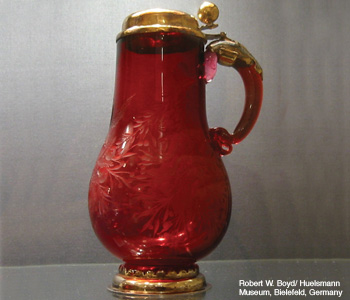Scatterings
Did You Know?
Plasmonics in Rennaissance glassblowing

Renaissance glassblowers may not have known about plasmonics, but they used at least one technique from the field to produce stunning results. This red carafe from Nuremberg, created circa 1700, is made of gold-doped glass. The gold particles, approximately 10 nm in diameter, fill only about 10–6 of the volume of the carafe’s glass, but they make the glass into a Maxwell-Garnett composite material with properties very different from those of their constituents.
…Log in or become a member to view the full text of this article.
This article may be available for purchase via the search at Optica Publishing Group.
Optica Members get the full text of Optics & Photonics News, plus a variety of other member benefits.
